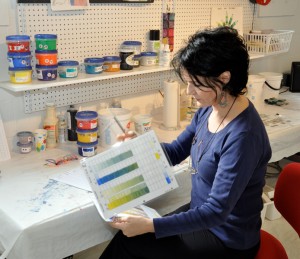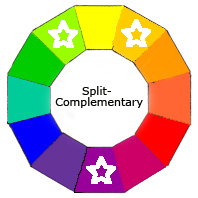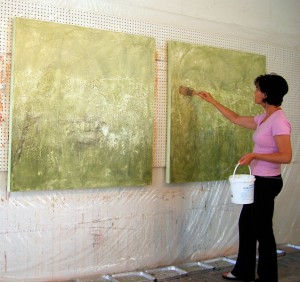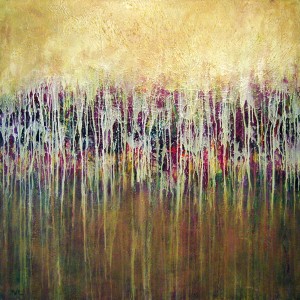
Shirley Williams has been a professional gallery artist for over 20 years. Her colorful, organic abstract paintings have been exhibited and collected internationally. Here she covers how the Munsell Color order system is used to create her artwork, from selecting pigments to mixing and applying them.
—-
I love color!!! – not just looking at it and painting with it, but studying it too. The most fascinating thing about studying color is you soon realize that the more you know, the more there always is to learn. Because I continue to study color and how it interacts, I’m frequently asked to speak and write about color.
People often wonder how I make sense of the millions of color choices when I’m painting. Some even assume that abstract painting is simply throwing a lot of colors on a canvas hoping some pleasing combination magically happens. Believe me, any painting, whether abstract or realistic requires some serious pre-planning of colors. Otherwise, it can become a clashing muddy brown mess in no time.
An Approach to Using Color in Your Art
Every artist has their own approach to selecting colors. There are no hard and fast rules, but all artists begin with a definite color scheme in mind.
- Step 1: I like to begin by reviewing past color tests and swatches. Every color scheme has a mood of its own. So, with the mood I want to create in mind, I choose a basic color scheme of two to four hues.

1. Studying Color Tests
- Step 2: In this example, I’ve selected a Split-Complementary color scheme on the Basic Color Wheel of Yellow/Green plus Yellow/Orange plus Purple. These three hues plus white and black will be the ONLY colors I will use in my painting.

2. Split Complementary Scheme
- Step 3: All my acrylic pigments have been pre-mixed to some degree. This gives me a wider range of subtle variations. Each container of pre-mixed pigment has been coded according to the Munsell notation system with the Hue, Chroma and Value. This makes selecting the pigments for each painting much easier because acrylic paint always looks darker once it dries.

3. Selecting Pigments
- Step 4: Having picked my three basic pigments based on the Split-Complementary color scheme, I get familiar with how they will mix together. The mixtures will be quite different depending on which of the colors is the dominant. In this example Purple is the dominant and a tiny bit of the Yellow/Green and Yellow/Orange is added to the Purple to shift the hue. I usually repeat this for each of the other two colors also, trying each one as the dominant. This helps me decide which of the three hues I want as the main color in my painting.

4. Basic Mixtures
- Step 5: After getting familiar with how the three hues mix with each other, I then try them out with white for tints, black for shades and grey for tones. By this time, I’m totally familiar with the total range of variations that can be created with these three colors.

5. Color Tests
- Step 6: Now it’s time to begin the painting. Usually I work on two or three paintings at a time. Working with the same color scheme and pigments, I challenge myself to create completely different versions by shifting the dominant color and its variations. In this example, I’m using the Yellow/Green with Grey as the underpainting. Once that’s dry, I continue adding layer upon layer until the painting is complete.

6. Underpainting Canvas
- Step 7: My preliminary color studies make it really easy to be in the flow while painting. There’s no guesswork about what color to choose next, or how two colors will mix together. The few hours I spend prior to getting started saves me from spending countless hours fixing mistakes.

7. The Finished painting: ‘Horizon’ ID# C-0911, 48 x 48 inches, Shirley Williams © 2009
After about two or three weeks, voila – the painting is finished. Believe it or not, I didn’t use any other colors except my three original color choices, Yellow/Green, Yellow/Orange and Purple, plus Black and White.



Leave a Reply